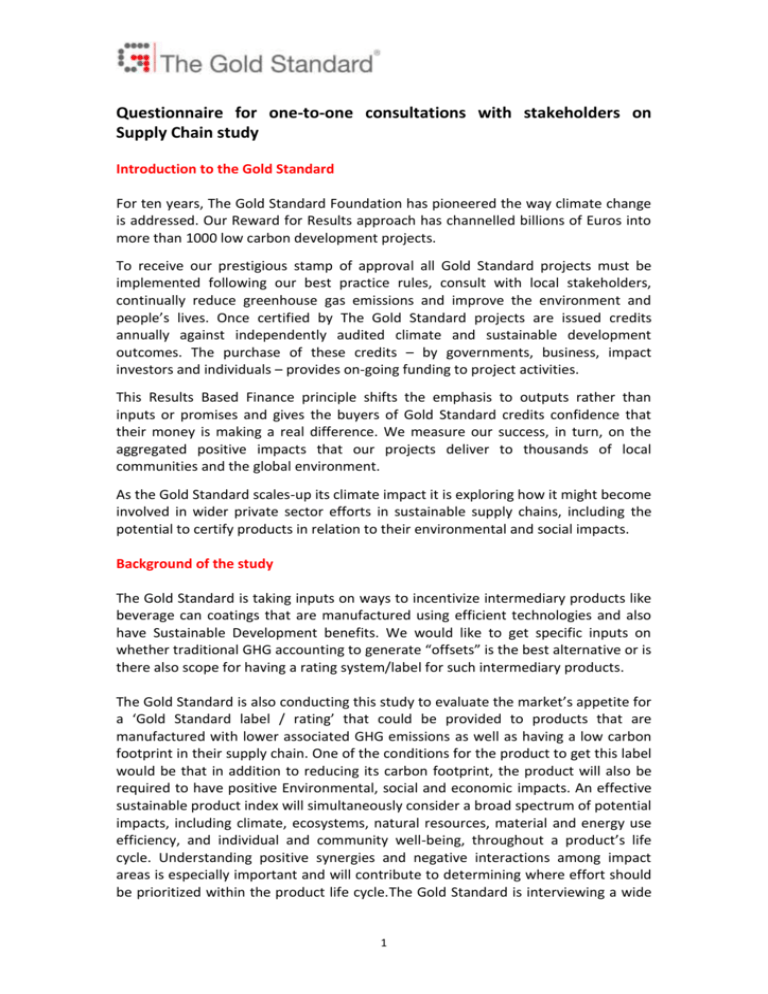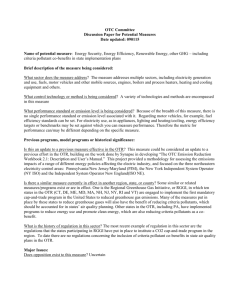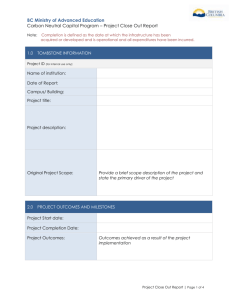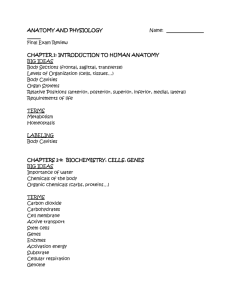Supply Chain Questionnaire results
advertisement

Questionnaire for one-to-one consultations with stakeholders on Supply Chain study Introduction to the Gold Standard For ten years, The Gold Standard Foundation has pioneered the way climate change is addressed. Our Reward for Results approach has channelled billions of Euros into more than 1000 low carbon development projects. To receive our prestigious stamp of approval all Gold Standard projects must be implemented following our best practice rules, consult with local stakeholders, continually reduce greenhouse gas emissions and improve the environment and people’s lives. Once certified by The Gold Standard projects are issued credits annually against independently audited climate and sustainable development outcomes. The purchase of these credits – by governments, business, impact investors and individuals – provides on-going funding to project activities. This Results Based Finance principle shifts the emphasis to outputs rather than inputs or promises and gives the buyers of Gold Standard credits confidence that their money is making a real difference. We measure our success, in turn, on the aggregated positive impacts that our projects deliver to thousands of local communities and the global environment. As the Gold Standard scales-up its climate impact it is exploring how it might become involved in wider private sector efforts in sustainable supply chains, including the potential to certify products in relation to their environmental and social impacts. Background of the study The Gold Standard is taking inputs on ways to incentivize intermediary products like beverage can coatings that are manufactured using efficient technologies and also have Sustainable Development benefits. We would like to get specific inputs on whether traditional GHG accounting to generate “offsets” is the best alternative or is there also scope for having a rating system/label for such intermediary products. The Gold Standard is also conducting this study to evaluate the market’s appetite for a ‘Gold Standard label / rating’ that could be provided to products that are manufactured with lower associated GHG emissions as well as having a low carbon footprint in their supply chain. One of the conditions for the product to get this label would be that in addition to reducing its carbon footprint, the product will also be required to have positive Environmental, social and economic impacts. An effective sustainable product index will simultaneously consider a broad spectrum of potential impacts, including climate, ecosystems, natural resources, material and energy use efficiency, and individual and community well-being, throughout a product’s life cycle. Understanding positive synergies and negative interactions among impact areas is especially important and will contribute to determining where effort should be prioritized within the product life cycle.The Gold Standard is interviewing a wide 1 gamut of stakeholders to understand if there is a market and demand for such an ‘ecolabel’. The Gold Standard is also soliciting feedback on specific sectors that could be targeted and the different attributes that will form the criteria for the label. Questionnaire Q1. Incentivizing efficiency in manufacturing of intermediary products Labelling the low carbon foot-print of end-products like beverages, furniture etc. has been going on for some time however there seems to be no direct incentive in labelling the efficient performance of intermediary products in the supply chain on standalone basis like beverage can coatings. What are the best ways to incentivize intermediary products in the supply chain that are produced efficiently and have strong Sustainability claims? Interesting concept on including the supply chain and where incentives may assist. Comes down to the final user of the product as in the example of beverage can coatings. If the bottler sees value in the efficiencies prior to their use i.e. willingness to pay more for the product then they are the ones to claim/label accordingly 1. GHG accounting and crediting for efficiency measures in the intermediary product manufacturing seems to bring tangible benefits in the form of carbon offsets. However, this approach is associated with inherent risks like uncertainty in the baseline, double claiming, additionality etc. Depends on whom will make a claim/assertion of efficiencies/emission reductions. In the early days of emission trading here in Ontario, Canada we used the rule of thumb that whoever pays for the improvement would be the party to claim the reductions. This worked well. More recently the ownership of “environmental attributes” is included in contacts where the purchasing parts claims ownership of all “environmental attributes” which includes any/every possible claim of environmental benefit. Thus double counting is technically avoided. a. What are the safeguards required to be put in place to avoid double claiming? This approach can result in double claiming of emission reductions as the credits finally issued by The Gold Standard may be bought by industries/corporates for offsetting their emissions when at the same time the product (can coating) buyer may also claim GHG reductions in its supply chain for regulatory/voluntary reporting purposes. The idea that carbon crediting could form part of an ‘in-supply chain’ incentive structure can be potentially looked at to address this issue. Again it comes back to contractual agreements and would work well if everyone subscribed to the Gold Standard. Issues however arise with how “policing” could occur with a multitude of registries in existence. Plus a fair bit of naivety in the marketplace. b. How to deal with uncertainty in determining the baseline emissions? In the case of the can coating example, where the emission reductions are due to a 2 change in one of the raw materials of the coating and where the baseline raw material is produced in petrochemical plants, the exact petro-chemical plant manufacturing the raw material will have to be identified in order to determine the energy consumed for producing the raw material. It will be a challenge to identify the plants that would have continued to supply the raw material for the baseline can coating over the crediting period of the project. It will be essential to identify these plants as National and International emission cap and trade schemes are being implemented across the world. I do not like the term “Business as Usual” but it would apply here. An industry standard would have to be applied so that a particularly “dirty” or non environmentally friendly facility could not make claims from their baseline but from what could be considered an appropriate baseline for the industry. c. How to deal with issues on additionality? For e.g. most products are becoming less carbon intensive as part of their normal evolution process so why would they need carbon revenues to be less carbon intensive? One of our criteria was that any reduction be real and voluntary in that an action was undertaken specifically to reduce emissions and are beyond business as usual. It is a complicated issue as everyone will claim project is additional when there is the potential of revenue from an offset stream. d. What are the other issues that should be dealt within the offset methodology for such projects? Current and pending regulation would play a major role in allowing credits/offsets. In some environmental circles it is felt that any reductions be beyond voluntary commitment which I have disagreed with as it would basically nullify any action. 2. Other ways of incentivizing intermediary products in the supply chain With an assumption that any action in the supply chain would directly affect pricing I think that incentivizing would have to come from the end user (in the example earlier a bottler employing a new coating). It would be their decision and their right to claim that they have caused an improvement in the supply side emissions…unless of course the new process in less expensive. Either a customer pays a higher price or addition environmental costs are claimed in an offset market a. What will be the right approach (labeling/indexing/rating) to operationalize this incentive b. What are issues that we should be taking care off in the selected approach? c. What would be the incentive for an intermediary product manufacturer to get the product labelled/rated d. Can the intermediary product approach be implemented independently of a product level system? Q2. Product labeling Product labeling may have its virtues however is the intent for end users? If so how much is the public expected to understand. If it is a simple label where a claim is 3 made that “production of this product produced lower emissions than the industry standard for an identical item…” However I would caution that if that product becomes more expensive due to its emission profile and a consumer makes a choice to pay more based on that labeling then they would be the ones claiming reductions. a. Is there an appetite in the market for a product labelling scheme that aims at incentivizing initiatives that promote broader Sustainable Development benefits by conducting a Sustainability indexing rather than focusing only on GHG foot-printing over the life cycle of the products? b. With most corporates reporting and communicating the Sustainability aspects of their businesses to their stakeholders, can the Gold Standard play a role in establishing such a product labeling scheme that go beyond carbon foot printing? c. We also realize that currently most schemes are limited to labeling of products from a particular sector like Foresty, agriculture etc. (apart from EU Ecolabel) so should we be thinking about transition from single-attribute labels of highly standardized products toward multi-attribute sustainability indexing of consumer products that account for heterogeneous product categories and complex supply networks? d. Also most schemes talk about ‘labeling’ only. In our opinion labeling does not provide comparison between same products from different manufacturers and does not create incentive for improving performance over time. So does rating a product on multiple sustainable development dimensions create more value for the products? Very difficult for labeling to compare different companies as opposed to industry standards. Labeling would lead to improving performance over time if the labeling caused companies to lose market share based on being an under performer. Almost a contradiction in philosophies in that pricing carbon is intended to raise prices on carbon intensive products when conversely action and labeling could raise prices. I understand that carbon offset pricing could level the playing field BUT labeling would have to specifically state the role of carbon pricing in making the product available and who would be claiming any environmental benefit. 4





